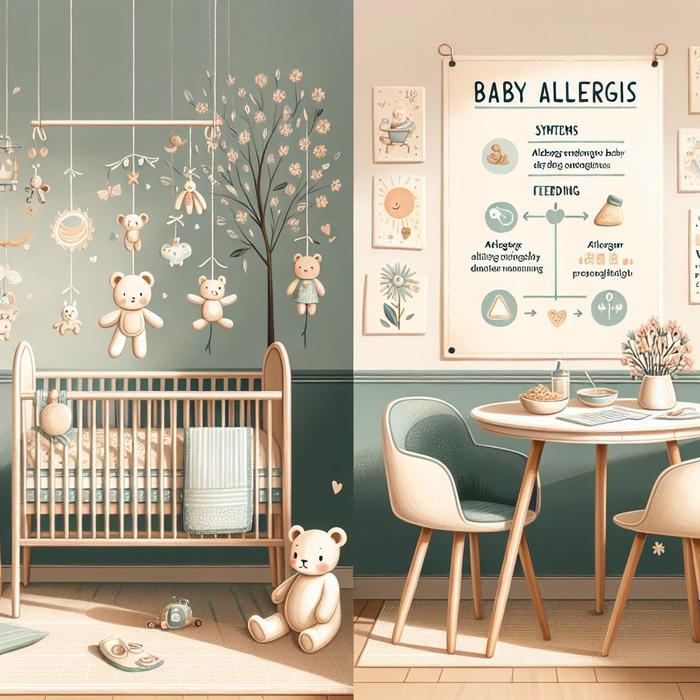Managing Baby Allergies: A Personal Experience
Navigating the world of parenting is challenging, and when your baby experiences an allergic reaction, it can be terrifying. As parents, we found ourselves part of this narrative. It was imperative for us to understand how to manage our baby’s allergies, recognize symptoms, and implement allergy-friendly tips. In this post, we’re sharing our personal experience and knowledge to ensure you are prepared to deal with such situations.
Recognizing the Symptoms of Allergies in Babies
Our baby’s first allergic reaction occurrence was unexpected. We weren’t sure what it was at first, but we later learned that the symptoms were indicative of an allergic reaction. According to the American College of Allergy, Asthma, & Immunology, these symptoms can range from mild to severe, and knowing them is crucial to managing baby allergies effectively.
- Hives: One of the most common signs of an allergic reaction in babies is hives. Our baby developed red, itchy bumps all over his body.
- Difficulty in breathing: This is an alarming symptom, which needs immediate attention. It can manifest as wheezing or coughing.
- Swelling: Swelling of the face, lips, or tongue can be a symptom of a severe allergic reaction.
- Vomiting or Diarrhea: Some babies might also exhibit gastrointestinal symptoms like vomiting or diarrhea.
Our Experience with Dealing with Anaphylaxis
Witnessing your child experience symptoms of anaphylaxis can be distressing, to say the least. According to Cleveland Clinic, anaphylaxis is a severe and potentially life-threatening allergic reaction that requires immediate medical attention.
During our encounter, we found that being calm, acting swiftly, and contacting a medical professional immediately were the keys to managing this crisis. We were also advised to always have an anaphylaxis emergency plan, which is discussed by the New York State Office of Children and Family Services.
Allergy-Friendly Tips We Employed
One of the most essential steps parents can take is to prevent potential allergens from coming into contact with their child. Here are a few allergy-friendly tips that we employed:
- Know the allergens: We kept a close eye on the foods that our baby consumed, especially when introducing new ones.
- Be vigilant: We always carried an epinephrine auto-injector for emergencies, as recommended by our pediatrician.
- Open communication: We ensured that everyone who took care of our baby, including babysitters and day-care staff members, knew about his allergy, symptoms to watch out for, and what to do in case of a reaction.
Managing baby allergies is a daunting task indeed, but with research, understanding, and careful planning, it is manageable. We hope that our personal experience will provide insight and guidance to parents navigating similar paths.
Creating Allergy-Free Environments
Another part of our journey has been ensuring our home and our baby’s environment are free from potential allergens. Here are a few procedures we incorporated into our daily routine:
- Dietary restrictions: We had to modify our diets to ensure the allergens were not present in any meals our baby consumed directly or indirectly, such as through breast milk.
- Cleanliness: We made sure our house, especially our baby’s play area, was clean. It helped reduce potential allergy triggers like dust mites or pet hair.
- Dedicated spaces: We created zones in our house that were allergen-free, just for our baby. This helped ensure our child had a safe area to rest, eat, and play.
Getting Professional Help
While we learned much from experience and research, we sought professional advice to manage our baby’s allergies better. We found great resources at the Regional Allergy Center that helped us understand the symptoms and management of food allergies. Furthermore, we consulted with pediatric allergists who guided us in understanding the root cause of the allergies and helped us form an effective management plan.
School and Allergies
Our journey took another twist when our baby started school. Ensuring he was safe in an environment out of our control was a difficult task. However, we found a fantastic guide by the Allergy & Asthma Network. The guide helped us understand how schools can manage allergies and gave us the confidence to send our child to school knowing he would be taken care of.
We strongly encourage all parents to look into this resource. It helped us understand that management is not just a home affair, but also includes school, sports facilities, and any other environments the child might encounter.
Coping with Food Allergies
Food allergies posed a major concern, hence we had to be vigilant. Researching about food allergens, we discovered that several food items could trigger allergies–anything from cow’s milk to eggs, peanuts and more could cause a reaction.
Relying on resources like Hopkins Medicine, we could develop a better understanding of food allergies and learn to manage them single-handedly.
Communication also played a major role here. Making sure that everyone who interacts with our child was aware of his allergies and knew what to do in an emergency helped us feel more at ease.
